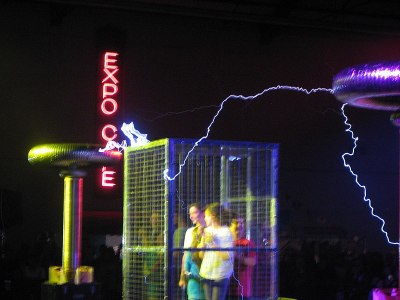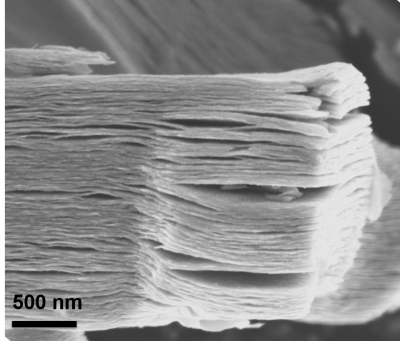Shielding is crucial for all manner of electronic devices. Whether you want to keep power supply noise out of an audio amplifier, or protect ICBMs against an electromagnetic pulse from a nuclear attack, the basic physics behind shielding remains the same. A Faraday cage or shield will do the trick.
At times, though, it would be desirable to shield and unshield a device at will. A new class of materials known as MXenes may be able to offer just that functionality, with microscopically thin films serving as shields that can be switched on and off at will.
Shut It Out

To understand how MXenes make a Faraday cage that can be switched on and off, first we must understand Faraday cages and shields themselves. Faraday shields are enclosures created out of conductive material that serve to block electromagnetic radiation from their interior. Faraday cages are much the same thing, but are built with mesh rather than out of continuous material. You’ve probably spotted shielding on all kinds of equipment, such as in stereo systems or your old Amiga 500. The basic principle is that an external electrical field around a Faraday shield causes the electric charges in the shield to distribute themselves in a way that cancels out the effect of the external field inside the shield itself.
Faraday shields tend to attenuate a broad range of frequencies quite effectively. In the case of Faraday cages, though, the size of the holes in the cage’s mesh play a major role in the penetration of electromagnetic radiation. Shorter wavelengths correspond to higher frequencies and will better pass through meshes with with a given hole size. A good rule of thumb is that the holes in the mesh should be less than 1/10th the size of the wavelength to be attenuated. For example, 2.4 GHz radio transmissions have a wavelength of 125 mm. Thus, a Faraday cage designed to block this frequency would require a mesh size less than 12.5 mm. Visible light, which is an electromagnetic wave with a much smaller wavelength, would readily pass through such a mesh.
Etch Away

The materials themselves consist of a conductive metallic layer in the form of a carbide, nitride, or carbonitride, sandwiched in between oxide layers. They are typically manufactured using transition metals like titanium, vanadium, niobium, or chromium. MXenes are made from from MAX phases, a family of hexagonal layered carbides and nitrides which also contain “Group A” elements like aluminium, germanium, or gallium. These Group A elements are removed or “etched” away via chemical processes, leaving the metallic (M) and carbon or nitride (X) atoms – hence the name.
The value of MXenes is that they are conductive, while having a mesh-like structure. If you’ve been following along so far, you’ll know that the dimensions of that mesh structure determine the material’s shielding ability as a Faraday cage. In the case of MXenes, the size of the holes in the mesh structure can be varied by combining the materials with an electrolyte solution. By applying an electric charge to the combination of electrolyte and MXene material, ions can be made to flow in a way that stretches or compresses the MXene structure. In turn, this varies the material’s conductivity and shielding performance.
As published in Nature, researchers have been able to make practical shielding using MXenes that can be switched on and off. In testing, a thin MXene film was able to variably attenuate or pass X-band signals, 8.2 GHz to 12.4 GHz, by applying potentials of less than a volt. The film readily held up to over 500 switching cycles in testing while sustaining the same level of performance. Future work will involve testing the material’s shielding performance at other frequency ranges, and increasing the strength of the shielding effect.
It builds on previous work that has explored the use of compressible conductive foams for the same purpose. The benefit of MXene films is that the same effect can be achieved on a much smaller level. Variable shielding foams are on the order of millimeters thick, and must be mechanically compressed or decompressed. MXene films, on the other hand, can be electrically controlled, and are less than a micrometer thick. They could even potentially be manufactured into microchips themselves as a variable, controllable RF shield.
It’s an exciting technology that could just be the new hotness in the RF world. Alternatively, MXenes could be the new graphene – the darling of the science media that still hasn’t delivered on all the fantastical promises once foretold. As always, time will tell. In any case, to avoid embarrassing yourself at a future conference, just know this: the term is pronounced “max-eens.”
















Switchable shielding is nice, but it sounds like you could also make all kinds of tunable stuff, like filters and antennas.
Do you one better: flip-flops. If this material operates the way I think, it’s entirely possible for it to be used for memory chips that are not affected by most sources of radiation. This can give us space immune microprocessors. NASA should be looking into this.
Would it really do much though? I’m not exactly sure what effect you’re picturing here so maybe I’m wrong but some googling suggests that normal faraday cages are basically useless against cosmic rays. Given how thin of layers these Mxenes are dealing with and the wide range of energy levels they’d have to shield against I’d be skeptical if they’d add enough protection to be worth the cost. The wikipedia article on radiation hardening suggests that a lot of the current techniques rely on insulating substrates instead of semiconductor ones and while I don’t fully understand the mxenes the article does say that their benefit is that they are conductive. Still I freely admit that I don’t have a lot better than a vague conceptual understanding of both RF shielding and how the mxenes do their thing so I could be totally wrong :shrug:
I think Rollyn01’s suggestion is to take advantage the material’s changing electrical properties in each state to store data, not to build tiny faraday cages for conventional memory.
Flip-flops?
I want to protect my brain from RF energy reading my thoughts,
not my feet!
“The dream police, they live inside of my head” and “Operation Mindcrime” come to mind Ren. Not that, that’s everyone situation… though seems to be something there for some if you read the reports.
Anything to help with the dipolar and ionic polarization or whatever effects we don’t need causing the cumulative oxidative stress and other ill effects that can injure and maim. B^|)
Glad something helped get my head on straighter when something wanted it off… reminded me of my first microwave assisted synthesis foray during my undergraduate research that I almost forgot had happened. https://wiki.anton-paar.com/us-en/microwave-assisted-synthesis/
Anyways, I was wondering about the polarization effects as I’ve observed that there may be gaps in Faraday Cages in regards to differences in attenuation at different polarization.
Kind of like I’ve wondered about very functional group and bond specific microwave (and IR) frequencies used to better catalyze reactions, where later I wondered about adding the dimension of polarization to the variables studied. Might be something there as an area of opportunity.
Well… really seems more like for the best performance, one needs an Anechoic Chamber Faraday Cage like design for the passive shielding role.
About the best graphical representation of Faraday Cage material data I’ve found where to this day I’m like… why isn’t there more literature regarding this topic?:
https://lh3.googleusercontent.com/-lHBaS2KMFno/TzFcx5v-lBI/AAAAAAAAARE/4bXNLyjK5sg/s1600/ShieldingMatrix.png
Reminds me of the FCC Part 15 Section 15.19(a)) labeling: “… (2) this device must accept
any interference received, including interference that may cause undesired operation.”
Worthy link to another somewhat related HaD article:
https://hackaday.com/2018/09/26/building-a-hardware-store-faraday-cage/
Cosmic ray are so energetic that their wavelength is below the width of an atom or in the same size as an atom. It’s not possible to shield against them except by dispersion, that it, having enough atoms that the probability of a ray to go through the thick layer is so low that it’s acceptable.
I’m immediately pronouncing it “mix-eens” just to be different and for its use of alloys. :-D
I’m going with “mux-eens” because I think with some clever switching these could make a multiplexer. 😃
¿Mexic-enes?
Si Senor!
This makes me wonder if you had a massive array of a semiconductor material could it have the same effect without the downside (“The film readily held up to over 500 switching cycles in testing while sustaining the same level of performance.”) by applying alternating voltages to change it from conducting to insulating.
Sort of like a diode, but opposite?
” 12.5 mm. Visible light, which is an electromagnetic wave with a much smaller wavelength, would readily pass through such a mesh.”
Ha, imagine light passing through 12.5mm (about half an inch), amazing what is possible eh.